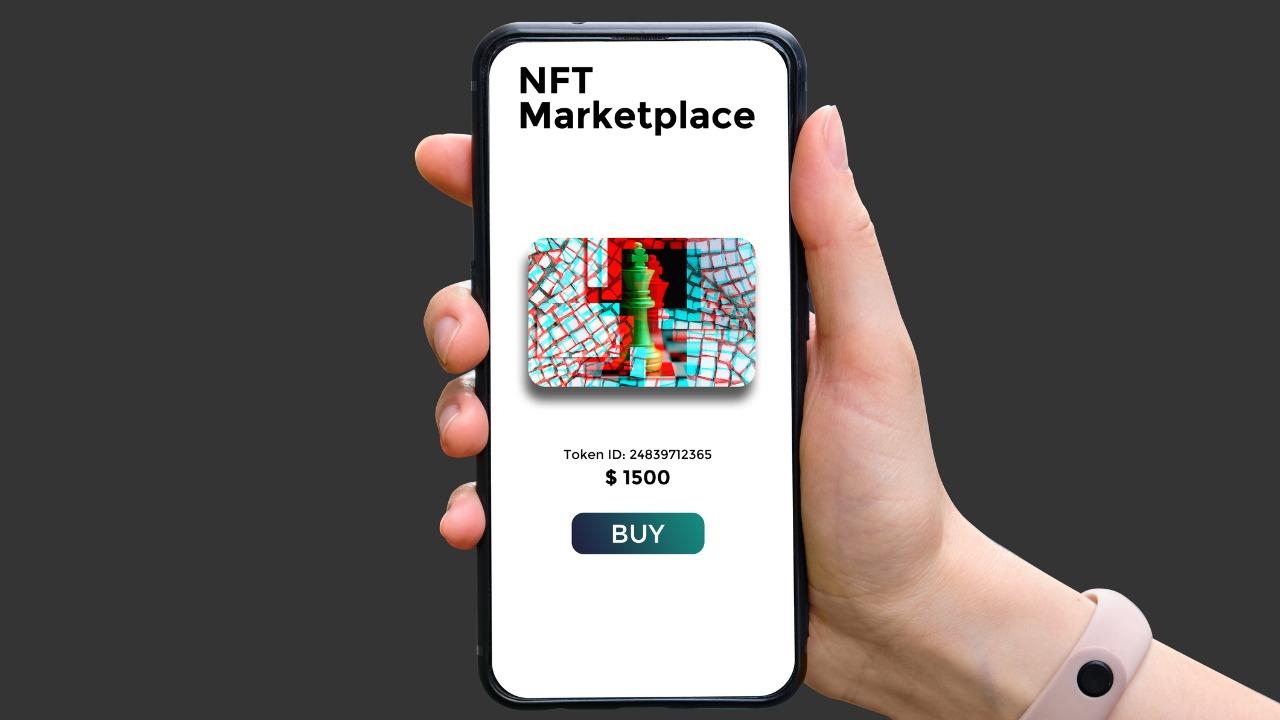NFT wallet apps facilitate the exchange of NFTs
The world of technology is advancing at a breakneck pace, and we are constantly striving for something better. While certain technologies improve daily, we are also fortunate with newer technology on occasion. NFTs, more popularly known as non-fungible tokens, is one of these emerging trends. It was not long ago that die-hard technology enthusiasts were introduced to NFTs, and their support and enthusiasm for them have propelled them to unprecedented heights. There are hundreds of NFTs made worldwide, and individuals are actively profiting from them.
It would not be incorrect to assert that NFTs have spawned a whole new market and revenue stream. Numerous mobile app assist in the creation, storage, sale, and purchase of NFTs. Similarly, we have . If you are considering constructing such an application, we would argue that there is nothing better.
However, there are a few things you should know before diving into NFT wallet app development.
What exactly is NFT?
You must learn the fundamentals of NFT before venturing into this new domain. We understand that you’re anxious to get started developing an NFT wallet and profiting immediately, but have you ever considered what NFT is? What is the aim of NFTs? How did they come to be and why are they garnering so much popularity? If you have not considered these questions previously, we are pleased to share this great insight before you launch your NFTs.
NFT is a form of cryptocurrency, however, it is slightly different. Whereas bitcoins, a type of cryptocurrency, have identical coins, NFTs are unique. They are used to digitally certify the property rights of physical and virtual assets. Another distinguishing feature of NFTs is their inability to be fungible or interchangeable. NFTs are digitally presented with a link to a blockchain-based marketplace where they can be sold by the owner. This is a brief review of NFTs; however, if you are interested in learning more, we invite you to do so.
How to generate and sell a non-fungible tokens
The increasing popularity of NFTs has persuaded many individuals to learn how to make them. Because you are developing a wallet specifically for NFTs, we have collected some news to give to you regarding the process of establishing an NFT.
One could argue that crypto-wallets could be utilized to conduct FNT transactions as well. Cryptocurrency wallets, on the other hand, do not support a variety of asset classifications, including artwork, entertainment videos, real estate, and loan contracts. NFT wallets let anyone easily hold, purchase, sell, and trade NFTs.
The Different Types of NFT Wallets
Because NFTs are relatively new to the market, one may have the impression that NFT wallets are not well-developed or up to date. On the contrary, NFT wallets perform admirably in terms of the user interface, customer experience, the technology utilized, and overall transaction speed. The following are some examples of NFT wallets that are now dominating the market and are well-liked by users:
Custodial NFT Wallet
Custodial wallets are NFT wallets that hold the currency in their users’ wallets in trust. Coinbase is a well-known example of a custodial wallet that operates centralized exchanges in the United States. Consider how these wallets operate. When a purchase is made and the user chooses to pay, the custodian wallet from which the payment is made stores the user’s cryptocurrency in its custodial wallet and functions as a third party. Along with the currency, it acquires possession of the user’s private keys.
They are viewed as a convenient entry point into the crypto realm by a large proportion of its users. All the user needs to do is create an account by providing an email address, verifying his identity, selecting a strong password, and linking his credit card to begin purchasing. Recognize that demand for and the number of custodial wallets is expanding rapidly.
Non Custodial NFT Wallet
After learning about custodial wallets, you may be curious about non-custodial wallets. Non-custodial wallets provide the user complete control over his crypto. There are no third parties involved, and the private keys are not shared or accessed.
Numerous people say it is the best, safest, and most secure wager. Additionally, it is considered a viable solution for days when a large number of crypto is required. However, opponents argue that it entails a great deal of responsibility because the user is responsible for all transactions.
How to create an NFT Wallet app
After gathered all of the information necessary to understand NFT’s reality, it is time to begin developing a mobile application that will serve as a wallet for NFTs. While this may appear to be a difficult undertaking, if you are familiar with the process of mobile app development, you will be surprised to learn that designing an NFT wallet is rather similar.
Deciding on a Platform
As with developing a mobile app, the first step in developing an NFT wallet is deciding on the platform on which it will be developed. By platform, we mean that you must choose the language to develop the app in. Android, Kotlin, Java, and Ruby are the most popular programming languages on the market.
While certain programming languages allow you to create programs that operate on a single platform, there are ways to create apps that aid users of several platforms in their use. It is recommended that you create a cross-platform application. It will enable you to reach a broader audience and create more revenue.
Market research
The second stage is to conduct market research on the market you wish to enter. This study will assist you in determining the type of application your consumers desire, the features they demand, your competitors, and the number of new enterprises to defeat. This information will assist you in better shaping your NFT wallet application.
One effective method of determining your users want to create a survey and distribute it to a large number of individuals. It will expose a wealth of information to you that you may not have discovered otherwise. You can use the results to create a full-featured app or have functionality determined for different versions.
Choosing the features of your NFT Wallet
As mentioned previously, you must decide on the final characteristics of your NFT wallet. There are numerous NFT wallets available on the market, and none of them offer the same functionality. Each wallet seeks to offer something unique to its clients to gain a competitive edge. The study conducted in the preceding stage should provide you with some ideas for features to include. If you’re interested in learning about more features, the following are some suggestions:
Authorization
This is the most frequently requested functionality in an NFT wallet. It enables a user to register on the app by filling out a form with his wallet’s access keys. You can need your user to register using either an email address or a mobile phone number. This feature enables them to reveal as little personal information as possible for the sake of transaction privacy.
Increased Security
It is not news that security is the most desired characteristic. By enabling two-factor authentication, you can take the security of your NFT wallet app to the next level. You can deliver the code via email, text message, or even Google Authenticator. Other popular methods of ensuring security include setting secret questions or requesting the cache.
Utilization of QR Codes
Speed is critical in the time we live in. Make transactions simple and time-saving for your clients by allowing them to scan QR codes. Similarly, for QR code acceptance, instruct them to create QR codes that can be shared with the payee.
Notifications
It may appear to be an ancient feature, but trust us when we say that customers still adore notifications. Notify your customers about new messages, payments received suspicious activities, withdrawals, and changes via their preferred channel or only through the app.
Interface That Is Simple To Use
One can create an NFT wallet with all the fantastic features a customer could ever want and still have them fail to utilize it due to the user interface. Your application must be developed with a simple and easy-to-use interface to ensure that the user’s trip is as seamless as possible. If your user encounters difficulties when using the software, be aware that they will soon abandon you in favor of a more suitable choice.
Designing out the app
After you’ve completed your research and determined your app’s features, it’s time to begin sketching your app. You should begin creating your app’s user interface. There is numerous app design software available for this step, however, we recommend Adobe Illustrator or Mock It. Both of these platforms are simple to use, especially for newcomers and have hundreds of stunning tools. Within a few hours, you can use these tools and become proficient with the software.
You may need to return and adjust a few app features. This needs you to ensure that the platform you choose is simple to use and does not demand a significant amount of time to create the final product. The appropriate platform will assist you in saving time and effort.
Technology selection
While each phase is critical in designing an NFT wallet application, this one requires further care. It asks you to select a technological stack on which to develop your app, and so can influence the app’s future as well. You can conduct your study to determine a technological stack, but we have some ideas to make as well.
It is recommended that you utilize Ethereum or Binance Smart Chain as the blockchain foundation, Ethereum Virtual Machine or Binance Smart Chain Virtual Machine for smart contracts, PHP, Codeigniter, or Laravel for website development, and AWS or Microsoft Azure for cloud hosting. Similarly, you can consider using Amazon SNS and Twilio for notification purposes, Redis and MySQL for database purposes, and Phantom-JS for additional functionality.
Begin the coding process
After deciding on a technological stack, you must begin constructing your application. It is recommended that you construct your software in smaller parts and continually promote these chunks to your users. Separate the features you wish to develop into smaller groupings. Develop only the critical or fundamental features required for the app’s launch. This will also save you time, money, and effort.
Testing
You must continue testing your software whenever you believe it is ready to launch in the market. You should deploy your software in beta form for some people to operate and test. Their input will supply you with invaluable insights that no developer could deliver. Additionally, you should build a team of quality assurance pros who can test the app in a variety of settings. They are individuals that have been taught to identify gaps that would take years for you to realize on your own. Make necessary changes immediately and schedule other changes for revision to create a new version.
Launching your NFT Wallet App
A common error committed by many developers is to launch the app completely developed. It is strongly recommended that you develop your app’s critical features first and then release it to the market as soon as feasible. The users will evaluate all of the app’s features and continue to provide valuable feedback. This will ensure that you hit the market on time, receive ongoing feedback from your clients, and have the time and energy to build subsequent versions based on the feedback. It is usually better to have certain features fail and recreate them than to have an entire app fail.
Conclusion
Without a question, NFTs have been ingrained in our daily life. NFT wallets create a single channel via which anyone can enter the market and generate revenue. Understanding NFTS alone is insufficient, as other concepts must be grasped to construct an NFT wallet. We’ve outlined a few procedures for launching a NFT wallet app. On a related topic, financial apps such as Metamask, Coinbase Wallet, Donaco, and Amazon Wallet can always serve as inspiration. These apps will help you gain a better understanding of the wallet app market, allowing you to create a game-changing app.
Los Angeles Software Developers doesn’t just dabble with NFT development; we’ve built hundreds of blockchain projects and have a track record of creating profitable NFT brands. Contact us to speak with one of our NFT Developers today.




